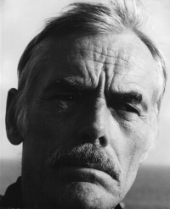 |
| Balcomb Greene |
Revved up over an English class
assignment to write a paper on "The Second Coming," by W. B. Yeats, I
stayed up all night crafting it, and thought I had hit a home run.
The professor, an awkward, gangly sort of fellow in his late-20s,
gave me a “C” on it.
Well, I just had to ask him to explain to
me what was wrong with the paper. In a private conference he told me
my analysis of the poem didn't jibe with the accepted school of
thought on what Yeats was saying. While admitting my writing and
analytical technique were fine, he nervously explained that I was
simply wrong in my conclusions, no matter how well-stated my case
might have been.
That sort of pissed me off, so I told him I
thought that ambiguity could imply multiple meanings, and it
deliberately invited alternative interpretations. Rather than defend
as his stance the man suddenly grabbed his face and broke into tears.
The
sobbing professor went into a monologue on the shambles his life had
fallen into. His personal life! Worst of all, he said, his deferral
had just been denied by Selective Service, so he would soon be
drafted.
He was wearing a pitiful brown suit. His thinning
beige hair was oiled flat against his scalp. My anger over the bad
grade turned into disgust. As I
remember it, I walked out of his office to keep from telling him what
I thought.
Now, four decades later, I regret my impatience
and feel sorry for the poor schlemiel. Still, when the offer came at
the end of the semester to expand my part-time job to full-time, I
took the leap. My chief duty was to schlep visiting scholars around
Virginia from one university campus to the next in a big black
Lincoln.
Each week, under the auspices of the University
Center in Virginia -- a consortium of Virginia colleges and
universities -- there was a new scholar in a different field.
Somebody had to drive them to lectures, dinners, convocations and to
hotels throughout the week. For one whole semester that was me.
Naturally,
in the crisscrossing of Virginia, the wiseguy driver and the
actually wise scholars had a lot of time to talk. Some of them kept
to themselves, mostly. Others were quite chatty, in several cases we
got along well and had great talks.
Three of them stand out
as having been the best company on the road: Daniel Callahan
(then-writer/editor at Commonweal Magazine), Henry D. Aiken
(writer/philosophy professor) and Balcomb Greene (artist/philosopher
and art history professor).
Callahan
challenged me to think more thoroughly about situational ethics and
morality. He was happy I was reading the books of Herman Hesse and
others. He turned me on to “One Dimensional Man,” by Herbert Marcuse.
Callahan was quite curious about my experiences taking LSD, we talked about drugs and religion. Click
here to read about him.
Aiken
(1912-‘82) was then the chairman of the philosophy department at
Brandeis University, he loved a debate. He was used to holding his own
against the likes of William F. Buckley. Talking with him about
everything under the sun in the wee hours, I first acquired a taste
for good Scotch whiskey (which I haven't tasted in many a year).
From
a ‘pragmatic’ point of view, political philosophy is a monster, and
whenever it has been taken seriously, the consequence, almost
invariably, has been revolution, war, and eventually, the police
state.
-- Henry D. Aiken
Aiken,
like Callahan, agreed to help me with a project I told them about.
Inspired by popular new magazines Ramparts, Avant-Garde, Rolling
Stone, etc. -- at 21-years-old -- I wanted to jump straight into
magazine publishing, with no experience, ASAP.
That dream
stayed on the back burner for 16 years, until the first issue of
SLANT came out in 1985. How I went about designing SLANT to be a small magazine, mostly featuring the work of its publisher, flowed in great part from my brief association with Balcomb Greene (1904-90). Of the rent-a-scholars I met, he was easily the funniest.
The son of a
Methodist minister, Greene grew up in small towns in the Midwest.
He studied philosophy at Syracuse University, psychology at the
University of Vienna and English at Columbia University. Then he
switched to art, having been influenced by his first wife, Gertrude
Glass, an artist he had married in 1926. He became a founder of the
avant-garde group known as American Abstract Artists in 1936.
After
World War II, just as abstract art was gaining acceptance, Greene
radically changed his style. He began painting in a more figurative,
yet dreamy, style that fractured time. Click
here,
and
here, to read about Greene and see examples of his work.
One
day I’ll write a piece about the visit to Sweetbriar with Greene.
It was a hoot collaborating with him, to have some fun putting on
the blue-haired art ladies of that venerable institution. This time
my mention of him is to get this piece to I.F. Stone. It was Greene
who gave me a subscription to I.F. Stone’s Weekly.
I.F.
“Izzy” Stone (1907-89) was an independent journalist in a way few
have ever been. In the 1960s his weekly newsletter was a powerful
voice challenging the government’s propaganda about the war in
Vietnam. Click
here to read about Stone, and
here.
"All governments lie, but disaster lies in wait for countries whose officials smoke the same hashish they give out."
-- I.F. Stone
Stone
remains one of my heroes. At my best, over the years, I have
emulated him in my own small ways. Thank you for the schooling,
Professor Greene.
-- 30 --









